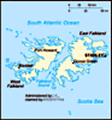Advertisement
Published: December 29th 2012
What an interesting day! The seas are quite calm when we get up about 7 am, and by 9 the ship has reached the Falkland Islands. The ship is too big for the inner harbour so we are tendered to shore in life boats. We are in Port Stanley by 10:30.
The Falklands (Islas Malvinas to Argentinians) are a remote group of two main islands and many hundreds of smaller ones in the South Atlantic some 900 k off the Argentine coast. The entire is population is 2500, and 2000 people live in the capital and only town, Port Stanley. There is a road linking Port Stanley to the military airport but no other roads. Residents use 4x4s and boats to get to all other parts of the islands. The primary industry is sheep farming, primarily for wool but also for meat. The islands are abuzz with the recent news that a major oil field is located just offshore. The landscape is desolate. There are no trees (save in backyard gardens) and the land is covered with moss, lichen, gorse and a few low, hardy shrubs. There are many exposed surfaces of rock jutting out, and some remarkable "rivers of
rock" winding down the mountains that were deposited by retreating glaciers thousands of years ago. The islands are warmed by the Brazilian current so the temperature is fairly consistent through the year, neither very warm or very cold. However, the weather is notorious for its capriciousness and violence; storms in this region are legendary. Another interesting factor is the land mines left behind by the Argentinians during the 1982 war with Great Britain. The mine fields are clearly marked with fences and signs, and you simply don't go near them. All in all, not an attractive place to live--except if you're a seabird or a penguin. The Falklands are one of the most important bird breeding sites in the world.
We have selected a tour to Bluff Cove where there is a major gentoo penguin rookery. We are first shuttled in a minibus along the one road heading south from Port Stanley by Stella, who describes the land and its history for us. When we reach the point nearest Bluff Cove, we are transferred to 4x4s for the trip across the moor. It's a crazy ride. Apparently there has been quite a bit more rain than usual in the last while, and the tracks are a muddy quagmire. Our driver Carol is awesome and doesn't get stuck once, even though we can see other vehicles get mired.
We get to the rookery after a 30-minute rocking and rolling ride. And there are penguins--hundreds of them, divided into three main groups. They are so cute. There's just no other word. And the sounds they make are incredible: a non-stop mix of honking and cooing. There are numerous chicks in evidence; they are old enough that they have most of the markings of their parents already. These is also a small group of king penguins mixed right in with the gentoos. The kings are slightly bigger, with long necks and orange markings. And they make an amazing sound that I can only describe as two elephants trumpeting at different pitches simultaneously.
We humans are allowed to approach the penguins to a boundary marked by white flags. But of course the penguins are free to ignore the flags, and they move from group to group as well as to the sea and back. They are cautious with us humans but not afraid, and some of them seem to enjoy posing for photographs. After overdosing on penguins, we wander over, as previously directed, to the Sea Cabbage Café (really just a mobile home) a little further down the beach, where we are treated to some amazing desserts baked by the locals, as well as tea and coffee. There is also a modest museum and gift shop there. it's not long before our hour is up and Carol arrives over the bluff to pick us up. The ride back is just as crazy, even worse in fact, because the tracks are already worse and, of course, we are now heading generally uphill. I wonder how the later tours are going to make it.
Back at the road, Stella picks us up in the minibus and heads back to town. She takes the scenic route this time to return to Port Stanley and points out significant landmarks and buildings along the way. Back at the pier, we amble along Ross Rd., the main drag of Port Stanley, for about three hours, shopping and taking pictures of the landmarks. There is, notably, a pretty little cathedral with an entrance arch made out of whalebone jaws and a monument to the British soldiers killed during the Falkland conflict.
It's now about 2:30 pm and Vi and I are somewhat hungry, so we strike off from Ross Rd. and find a little pub. Inside we are immediately befriended by "Happy Paddy," who has clearly been at the pub for some time. He tells us his life story in excruciating detail as we order a brew and fish and chips, which are excellent. Another local who chats us up is Vera, who has a nephew living in Trenton, Ont. She spoke with him just yesterday and he was telling her about all the snow.
We eventually extricate ourselves from Paddy and make our way back to the pier where we catch the tender back to the ship. On the way, Violet catches a glimpse of magellenic penguins porpoising through the water.
Some time to relax and unwind before supper. The ship leaves port about 9 pm. The evening's entertainment is a Las Vegas-style singer/comedian named Doug Starks, who does a good job with a bit of a subdued crowd.
Advertisement
Tot: 0.062s; Tpl: 0.011s; cc: 9; qc: 29; dbt: 0.0366s; 1; m:domysql w:travelblog (10.17.0.13); sld: 1;
; mem: 1.1mb







